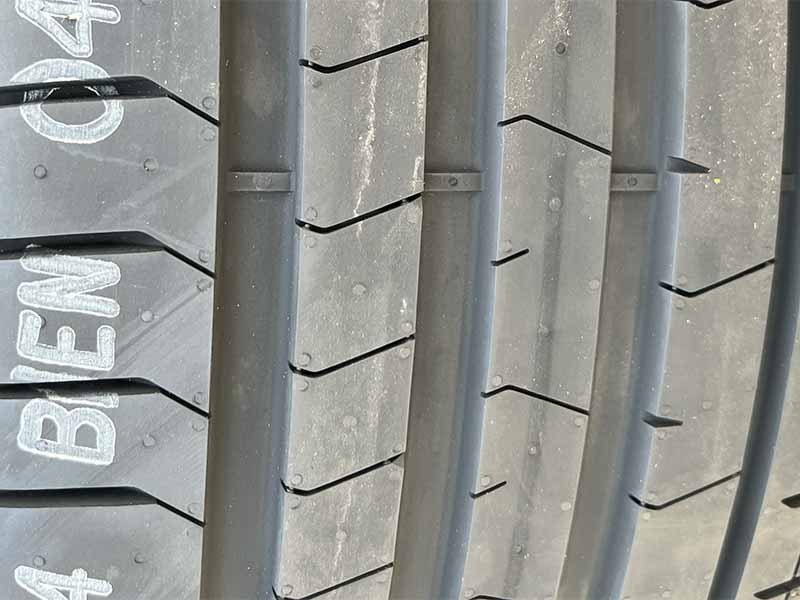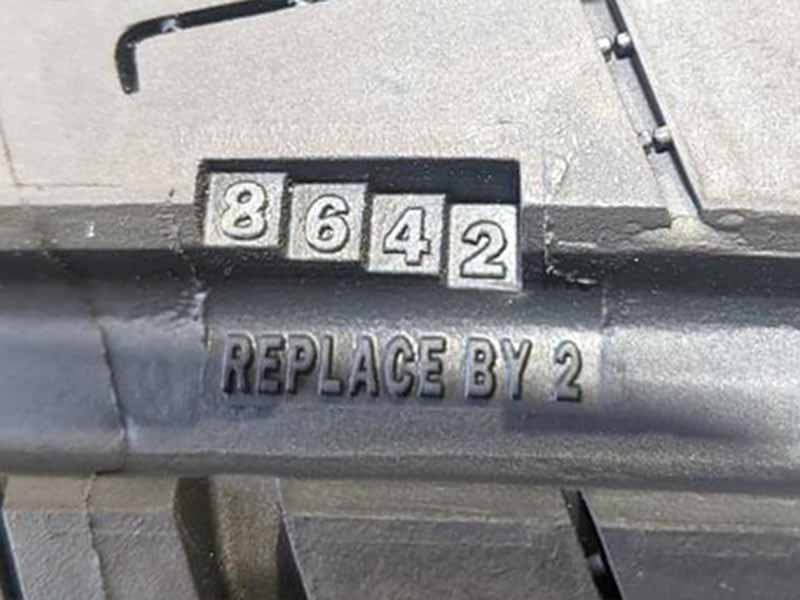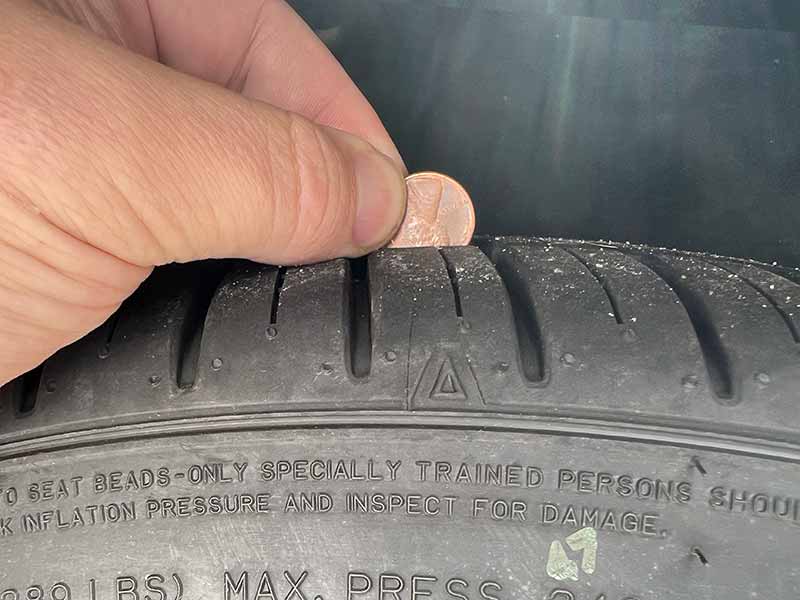Understanding how to measure tread depth without a gauge is important so you can easily determine when it’s time for your tires to be replaced.
Using a penny to check tire tread depth is convenient, simple, and accurate enough to see if you’re in the danger zone or if you still have plenty of life left in your vehicle’s tires.
How To Check Tire Tread With A Penny
Penny Test:
- Place a penny upside down in the deep tread grooves between tread ribs.
- If all of Lincoln’s head is visible you should replace your tires immediately.
- If all of Lincoln’s forehead is visible, you should consider replacing your tires soon.
- If part of Lincoln’s forehead is obscured by your tire treads, your tread is at an acceptable depth.
The penny test is a very handy method for testing your tires. It’s easy to perform this test, but it’s important to understand how different depths affect how your tire treads grip wet roads and why you might want to consider replacing your tires sooner than waiting until they are considered bald.
Let’s take a closer look.
Penny Tread Depth Chart
4/32 Tire Tread Penny Mark (Lincoln’s Forehead)
The distance between the top of a penny and Lincoln’s forehead is exactly 4/32″. When a penny is inserted upside down into a tread groove between the tread ribs, if the top of the tread block lines up with Lincoln’s forehead, your tread depth is exactly 4/32″.
This is the point at which you should consider replacing your tires. At 4/32″, your tire’s wet weather performance will be significantly reduced compared to that of new tires. Also, grip in wet conditions will continue to reduce more rapidly as the tread depth continues to wear down.
2/32 Tire Tread Penny Mark (Top Of Lincoln’s Head)
The distance between the top of a penny and Lincoln’s head is exactly 2/32″. When a penny is inserted upside down into a tread groove between the tread ribs, if the top of the tread block lines up with the top of Lincoln’s head, your tread depth is exactly 2/32″.
This is the minimum legal tread depth. Tire performance in rainy weather will be extremely poor and stopping distances will be dramatically longer than new tires or even tires with 4/32″ of tread depth.
Tire Wear Indicator Chart
Wet Weather Stopping Distance
Stopping distance can become much longer when you have less tread left on your tires. The difference in stopping distances between new tires and worn tires is dramatic.
As you can see in the stopping distance illustration, it can take twice the distance to come to a complete stop in moderate rain conditions when your tires are worn to the minimum allowable depth.
Minimum Safe Tire Tread Depth
The minimum safe tread depth is legally considered 2/32″, however, 3/32″ or 4/32″ are significantly safer tread depths. You can replace tires earlier than 2/32″ to significantly improve traction in wet conditions.
The cost to replace tires at 1/32″ higher tread depth is a very reasonable tradeoff for the significant improvement in wet traction.
Tread Depth Calculator
Is The Penny Test For Tires Accurate?
The penny test is a very accurate method to check your tire tread depth to determine if you need to replace your tires. It is not a good measure for finding the exact tread depth unless it happens to line up with the top of Lincoln’s head or forehead.
If you want to measure the exact tread depth, you will want to use a proper tire tread depth gauge. A tread depth gauge will give you precise measurements in 1/32″ increments.
How To Check Tire Tread With A Quarter?
To perform the quarter test you will need a Washington quarter. Washington quarters are harder to come by these days but if you don’t have a penny and happen to have a Washington quarter, the quarter test is a good alternative.
The distance between the edge of the quarter and the top of Washington’s head is approximately 4/32″.
Quarter Test
- Place a quarter upside down in the tread groove.
- If any portion of Washington’s head disappears behind a tread block, your tire tread depth is within a safe driving range.
- If Washington’s entire head is visible it’s time to replace your tires.
Tire Tread Wear Indicator
Tires have built-in wear indicators called wear bars. The wear bars are down in the valley between tread ribs but are 2/32″ above the bottom of the groove between tread blocks.
Once the tread wears down to become flush with the top of the wear bars it’s time to replace your tires.

Some manufacturers will include different styles of tire wear indicators. For instance, the image below is from a Goodyear tire.

New Tire Tread Depth
The tire tread depth of new tires is usually 10/32″ or more. This amount of depth can allow for years of driving without safety concerns for most tires.
New tires will perform the best on wet roads and your tires will slowly lose traction as they become worn down. Fortunately, as your tires wear over time, the decrease in performance is very small and begins to become exponentially worse as you begin getting closer and closer to the minimum legal tread depth.
The last few 1/32″ of tread depth have particularly poor wet weather performance. This is why it is recommended for your safety to consider tire replacement before you actually reach the minimum tire tread depth.
How Often Should You Check Your Tire Tread
The recommended frequency to check tire tread depth is monthly. You can do this with the penny test, but it is recommended to be done with a proper tread depth gauge.
The reason you should check tire tread depth monthly is to not only ensure you have enough depth between your tire treads to allow water to flow away from underneath the contact patch but to also ensure even tire wear.
You should check tire tread depth at several points around the whole tire. This will allow you to determine how evenly your tires are wearing over time and help you identify uneven tire wear patterns early.
Using the penny test won’t be as helpful since it doesn’t allow you to more accurately see actual depth measurements.
Tire Tread Depth Gauge
You can check tire tread depth more accurately with a depth gauge. These inexpensive devices can accurately measure the depth of your tire tread to give you a better idea of exactly how much tread wear life is left.
The penny test is accurate for finding if your tires are worn to a point that is unsafe or needs to be replaced, but it can’t give you precise measurements unless they happen to fall on 2/32″ or 4/32″.
Tire tread gauges come in different designs. The most common design is the stick style gauge. To use one, you simply place the metal probe into the deepest tread groove and allow the probe to push in until the gauge stop comes into contact with the top of the tread blocks.
You can then read the position the gauge has stopped to determine the depth of the remaining tread. Readings will be in 1/32″ or 1mm increments.
Dial-type gauges are easier to read with their larger display. They are also just as simple to use and work in the same way as the stick design.
Dial depth gauges come with a metal probe that can be inserted in the same manner as a stick gauge. The housing of the dial gauge acts as a gauge stop. Once the housing is resting on the top of the tread, you can remove it to read the depth.
Digital gauges are also available but I wouldn’t recommend them. They are easy to read but tend to measure a bit too inconsistently. They also require batteries which means that at some point they will need replacing. This will likely be when you need to use it and batteries won’t be handy.
Analog gauges work just as well and don’t have this problem.
Uneven Tire Wear
Uneven wear patterns on your tire treads are a sign of problems that are affecting your tires. Some common issues that can lead to uneven wear are:
- Low air pressure
- High air pressure
- Infrequent tire rotation
- Alignment problems
- Worn suspension components
Uneven wear can significantly reduce the life of your tires. When you test the depths around your tires, be sure to pay attention to inner and outer shoulder wear as well as variations in wear around the circumference of the tire.
Be sure to check out our article on uneven wear patterns to learn more about uneven wear and what causes unique patterns.
Resources
Below are some links you may find helpful when learning about tires
Final Thoughts
Your tires are extremely important. They are the only part of your car or truck that comes into contact with the road surface. Ensuring they are in good shape is the most important safety test you can do regularly.
Also, maintaining proper air pressure, rotating them regularly, and keeping them balanced and aligned properly are all keys to getting the best wet performance and life out of them.
Good luck and happy motoring.









